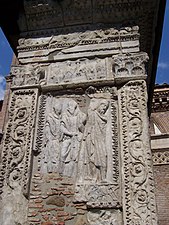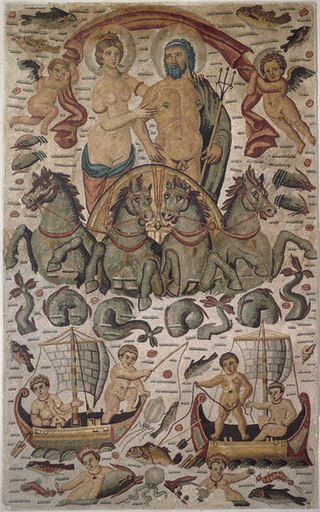Types
Argentarii

The argentarii, also known as argenteae mensae exercitores, negotiatores stipis argentariae, [10] [11] and argenti distractores, were private money changers in ancient Rome supervised by the government. [12] [13] [14] This group was organized into a guild with a limited number of members. They were commonly located at stalls, shops, tabernae, and in the forum. [15] These locations were built by the censors and owned by the state. [16] [17]
The argentarii provided numerous services, such as providing loans, [18] holding money, circulating money, exchanging currency, [19] providing credit at auctions, and determining the quality and material of currency. They were also entrusted with paying off debts. [20] Their powers would expand to include almost all forms of financial transactions. Despite this, their primary goal was to exchange foreign currency for Roman currency. [17] Typically the clients of this group were not wealthy, as the upper class of ancient Rome had more secure methods of storing wealth. [21]
Another group known as the expectores were tasked with keeping financial records, including those of the argentarii. [22] The argentarii were likely founded around the 4th century BCE. When they were established, they likely only functioned as a replacement for the previous Greek trapezitai and their abilities were likely limited to money-handling. [23] By the 1st century BCE they were capable of providing credit. [24] They disappeared from the historical record for around 70 to 80 years after 250 CE for unknown reasons. [25]
Mensarii
The mensarii were state-appointed public bankers. [26] [27] [28] Usually they were appointed during periods of poverty or war. Their goal was to prevent social unrest and help the plebeians overcome debt and economic hardships. [29] [30] [31] This organization was established in 352 BCE to combat high levels of debt as a five-man commission known as the quinqueviri mensarii. [32] [33] They accomplished this by providing the population access to public services and loans as well as managing the circulation of currency. [34] [35] [36]
This group would evolve into the triumviri mensarii in 216 BCE. [37] [38] [39] This was a commission of only three people, but performed the same duties as the previous organization. [40] [41] These two groups could perform similar functions to the argentarii, such as money holding and assaying currency. [17] [42] [15]
Coactores

The coactores collected and gave money to their employers. [43] [44] [45] They were used by the argentarii for this function since the 1st century BCE, and they disappeared from the historical record after the 2nd century CE. This organization was distinct from the argentarii. [46]
There was another group in ancient Rome known as the coactores argentarii, who were responsible for depositing money and collecting debts at auctions. [47] [48] Neither of these groups provided credit to companies,[ clarification needed ] nor did they grant loans to finance consumption; although they granted short-term commercial loans. [49]
Nummularii
The nummularii were a group designed to mint and test new currency. To do this they examined the metal which was used to make the coins using their senses and the patterns of the coins. [27] They first appeared in the historical record in the 2nd century BCE as money-changers. By the 2nd century CE they began to provide loans, deposit currency, and operate bank accounts.
They ran a bank and put new currency into circulation and they removed foreign or old coins from circulation. [50] Alongside this they could hold money, sell goods, work at auctions, maintain records, exchange currency, and make payments on behalf of their clients. [17] [38] By the 3rd century, they were the last banking profession in ancient Rome, and they handled all banking affairs. [46] [51]












